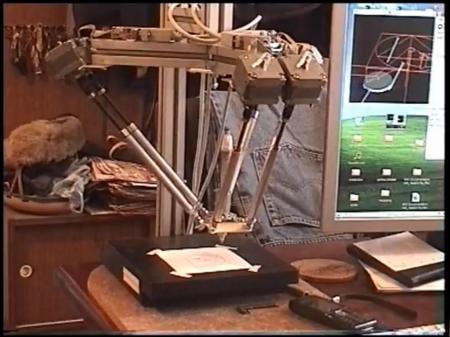Although some may have heard of a machine like this, the CNC tripod remains an unknown machine to many in the engineering word. This particular machine is set up as a plotter, drawing incredibly straight lines, shapes, and letters.
The machine appears to have 6 servo motors, 3 working as pairs. This would simplify control and allows the pen to be held at a perpendicular angle to the paper. Once could envision this being used with, instead of a pen, a spindle and mill. Instead of the traditional movement of a CNC mill or router, this could be used to cut out complex shapes.
Additionally, if the servos were not driven in 3 tandem pairs, but were all controlled independently, it should be possible to twist the tool in a controlled angular direction. This would add an extra axis of control to an already robust CNC setup. It will be exciting to see how this technology develops in the future. Until then, check out the video after the break:
[youtube http://www.youtube.com/watch?v=LJYhz5aTMnA&w=470&h=349%5D
Also, for another alternate machining method, check out this “CNC hexapod.” Really cool as well.















Sweet!
WOW very Cool!!
Pretty sure those are stepper motors.
These are steppers, not servos.
professionally built mill performs just as well as you had imagined:
http://www.youtube.com/watch?v=NDzUiZsbQtw&feature=related
Nice machine but I can see some flaws. The UJs coupling the motors to the threads are going to introduce some non-linearity at the extremes. That could be accounted for in software but CV joints are what you really need there.
The threaded rod into a tube is difficult to get both lash and flex free. It looks like there are nuts of some sort at the tops of the tubes to help with backlash, but I can see plenty of flex particularly in the leftmost pair.
Pretty cool that EMC can be made to control it accurately though. Now let’s see the extra degrees of freedom ;-)
@dave: Wow! I want one of those.
@dave.
That is shockingly disturbing. I don’t want to know how much it cost to develop the control software.
@all – right steppers, my mistake.
@Dave – Thx for the video! Yes, that is as incredible as I’d imagined. Didn’t know these were made as actual professionally built CNC machines!
That’s really slick! Nice work.
I can only imagine how terrible you would feel if you were the guy to crash that Okuma! ouch
straying away from traditional orthogonal axes, id be curious to see the math involved with the code that drives the motors based on the mapping data… im scared to think about if it included more three dimensional controls to the head.
Strange to have a non-symmetric 2×2 as a setup, you’d expect a symmetric 3-sided setup.
Check out the Tricept concept by Loxin.
Spanish machine company has been selling custom Tricept machines for years.
Also… Renishaw has a comparator CMM type gauge called the Equator which looks exactly like this.
Good work though… not to detract from you..
This motion control concept is just starting to see some light in the market.
@Whatnot… it looks 3 sided to me. (in the video anyway. The still photo looks like something’s missing because the rear actuators are almost inline with the front ones)
The concept is great as a full CNC machine, but the engineering can be tricky due to the torque of the spindle motors. Real machines like this would have to be servo – not steppers.
How is this tripod different than a delta robot?
http://www.youtube.com/watch?v=foTE0Mau5a8
Another iteration in the following video. This moves the work instead of the cutting head as it is a add-on for a standard bridgeport type knee mill.
http://www.youtube.com/watch?v=5hYAD77mdCI
@wernicke
A Delta robot works with three arms that are rotating rather than changing length as this one does. I’m not sure what the name for this setup, but it’s quite different, and I would imagine allows for higher accuracy due to increased rigidity with the trade off of slower speeds.
Neat build.
Umm… there are only 4 motors, not 6. Look closer at the picture, the arms are orthogonal.
If you watch the video you can see all six motors
@Jeff
Its still a hexapod, just a different combination of the 6 actuators.
I believe the one macona posted is called a Stewart platform:
http://en.wikipedia.org/wiki/Stewart_platform
The one in the post can be considered a subset of the Stewart in that it isn’t using some of the degrees of freedom at its disposal.
I like it. It’s faster than I thought it would be. If the magnets were replaced with “real” ball joints, it could likely move considerably more weight than the pen it’s currently holding. If I had one, I’d either drive all six motors separately and use it like an upside-down version of the one macona posted (i.e. move/tilt the material around a fixed cutting tool), or mount an extruder head in place of the pen and make a 3-D printer.
Also, actual linear stepper motors might have better lash/flex characteristics:
http://www.youtube.com/watch?v=We4jWOW7khI
This is related: http://www.youtube.com/watch?v=H5ZDFBBiiSE
I’ve never seen something like this…
Amazingly cool. Maybe I should dust off my delta bot and make it into something “useful”
A machine shop in China have supplied me some stepper motors and controllers for a similar project. 150W units for something like $50 a pop. So hardware wise it will not be that difficult/expensive. BUT, scary to think what did the CODE involve making this work….